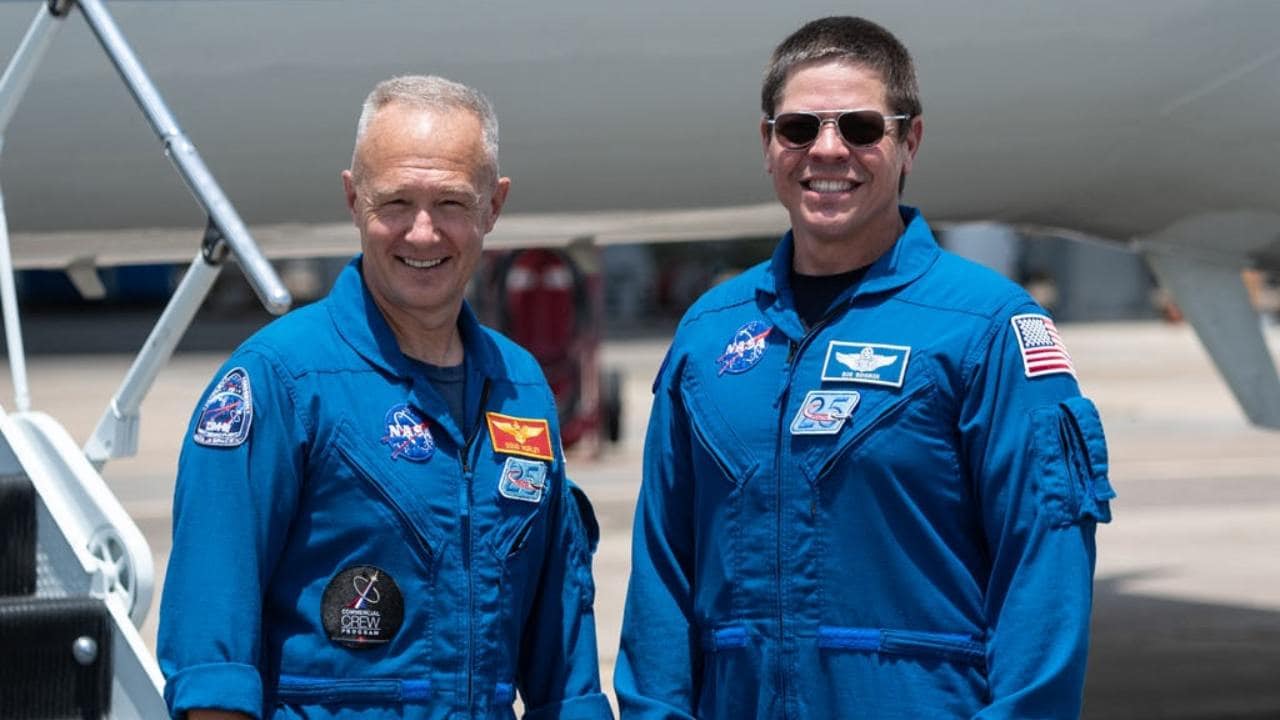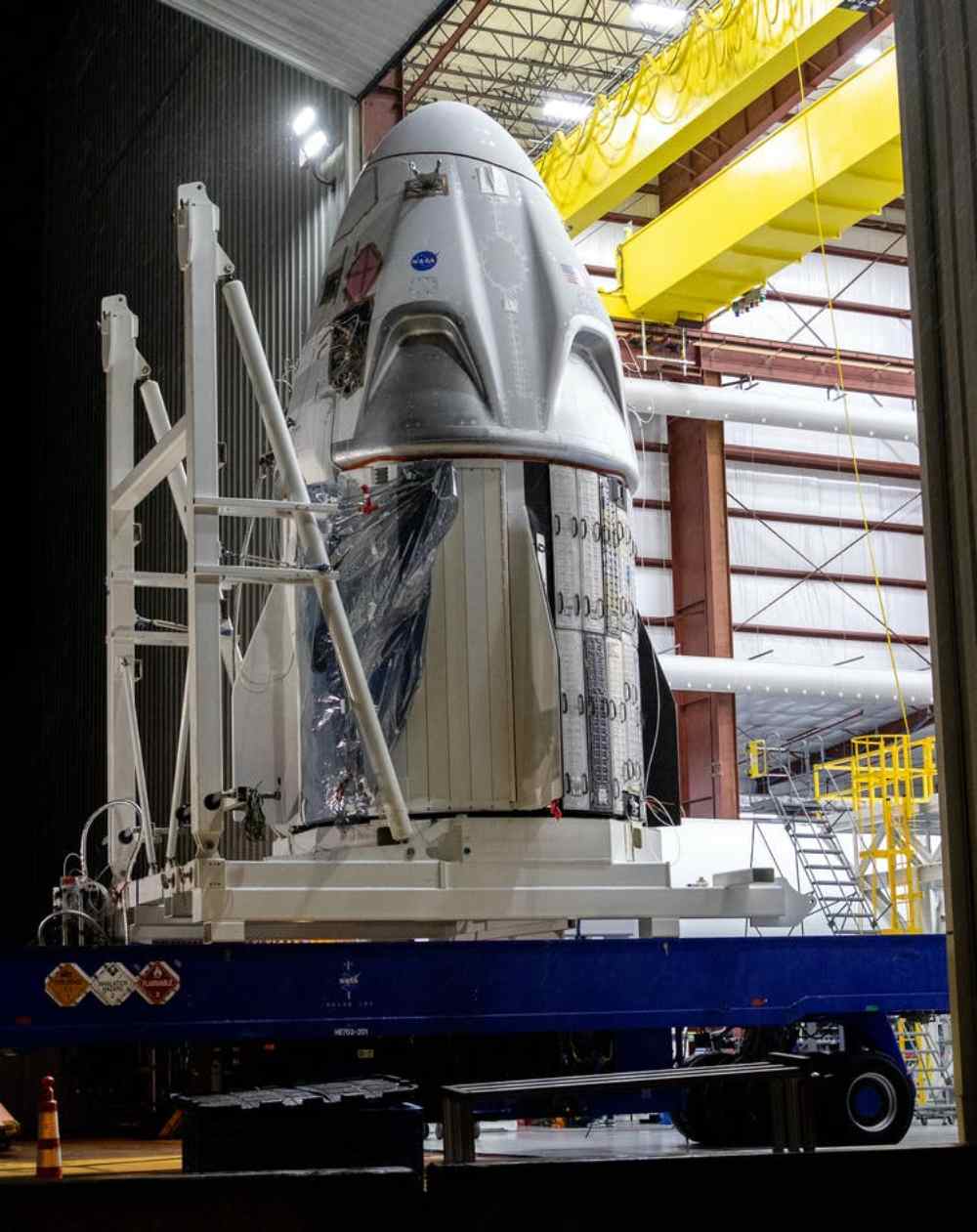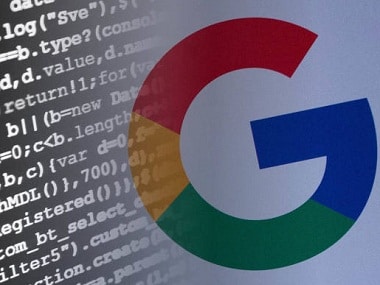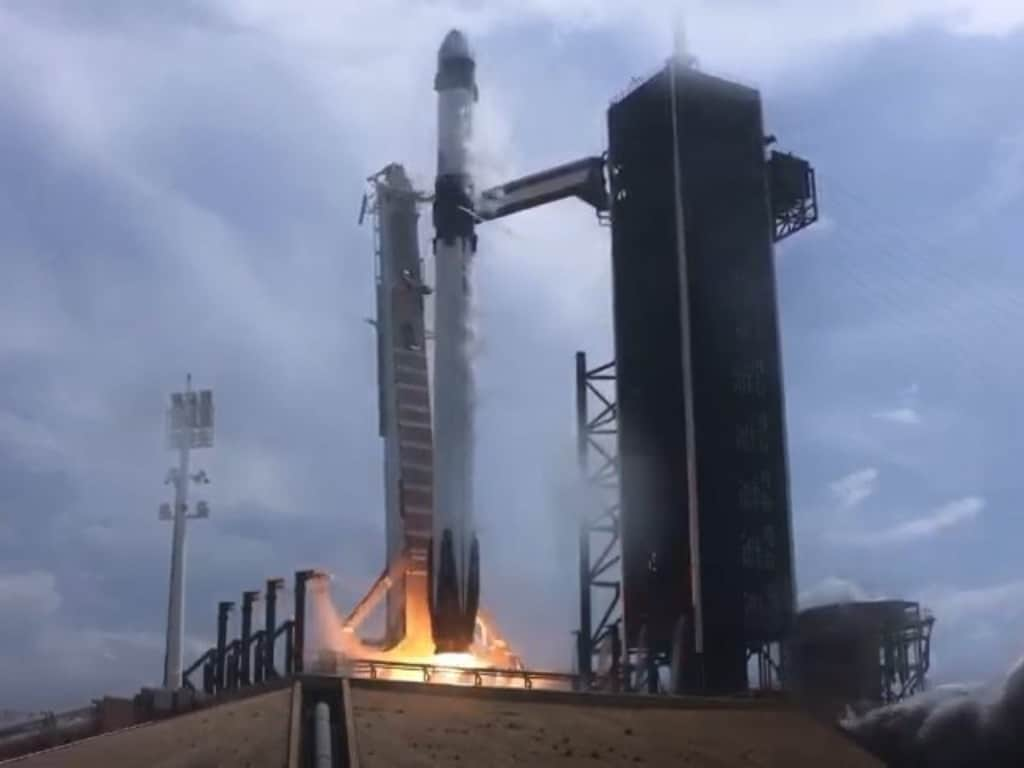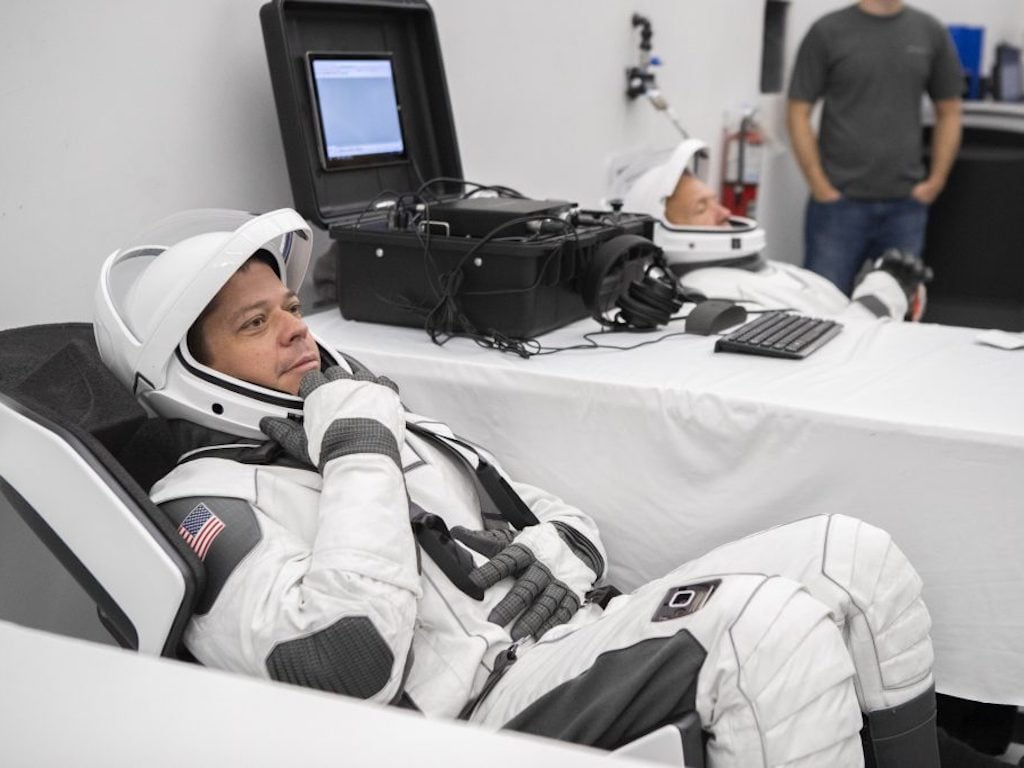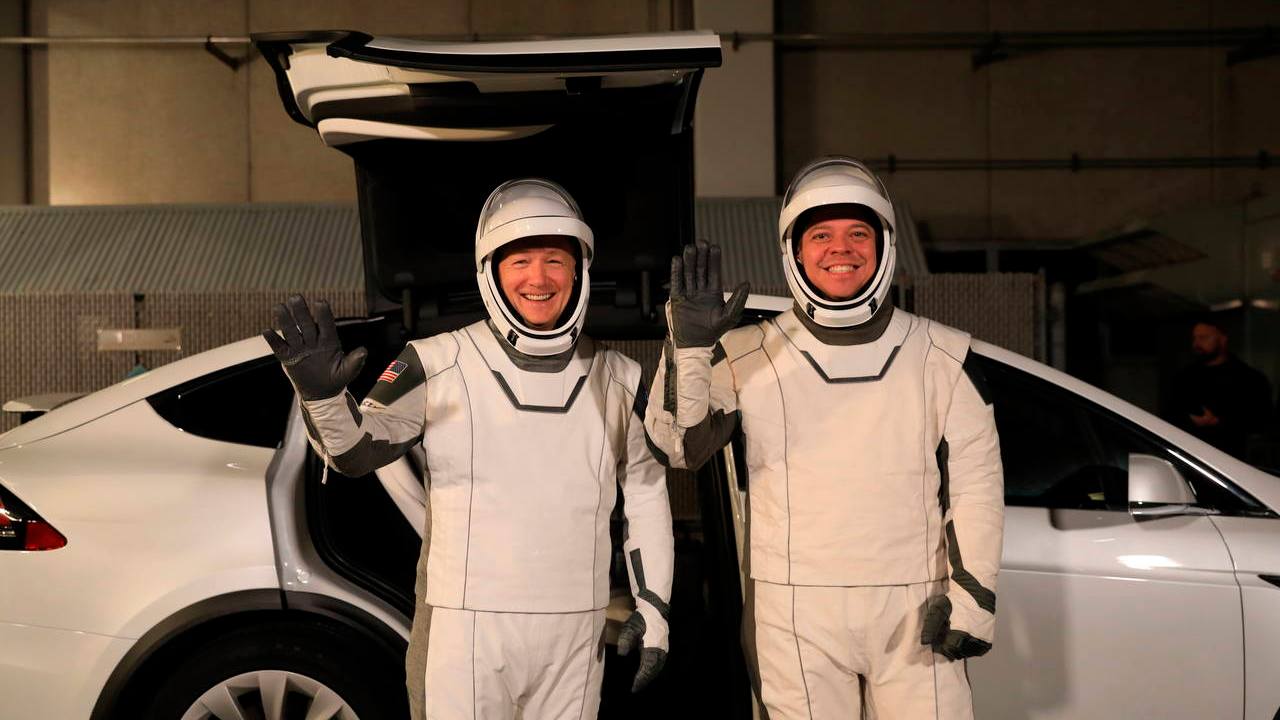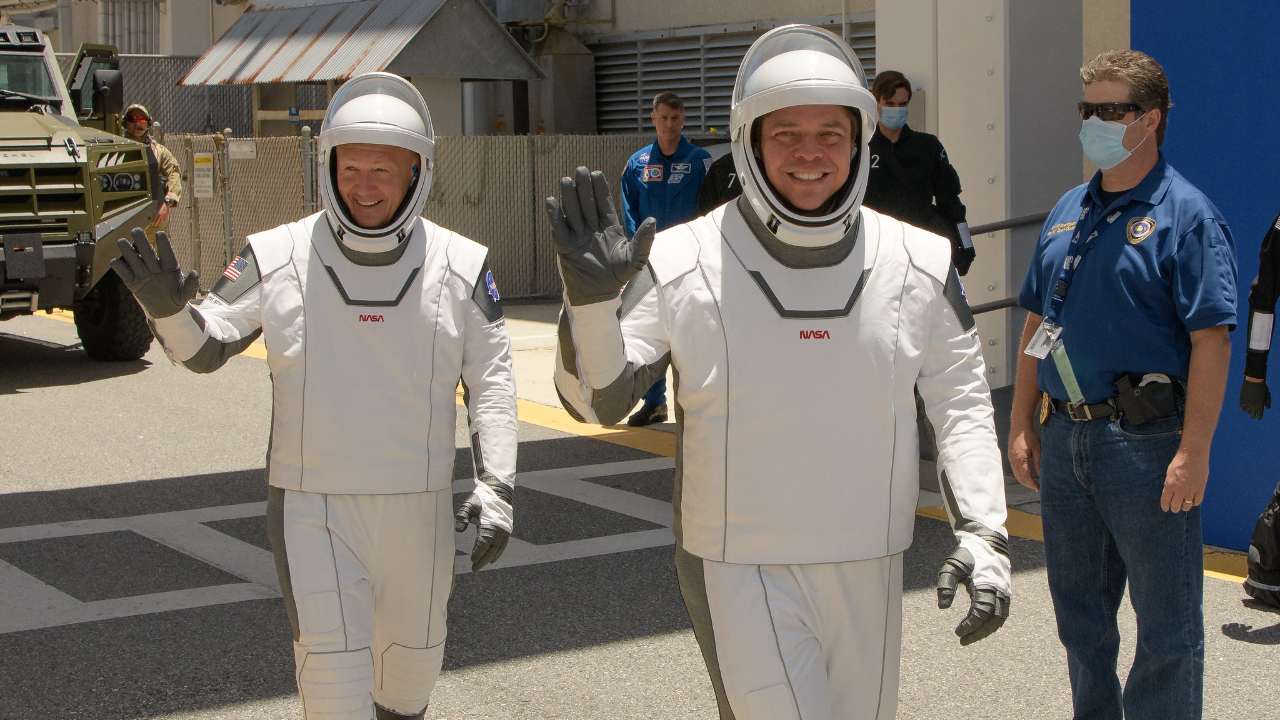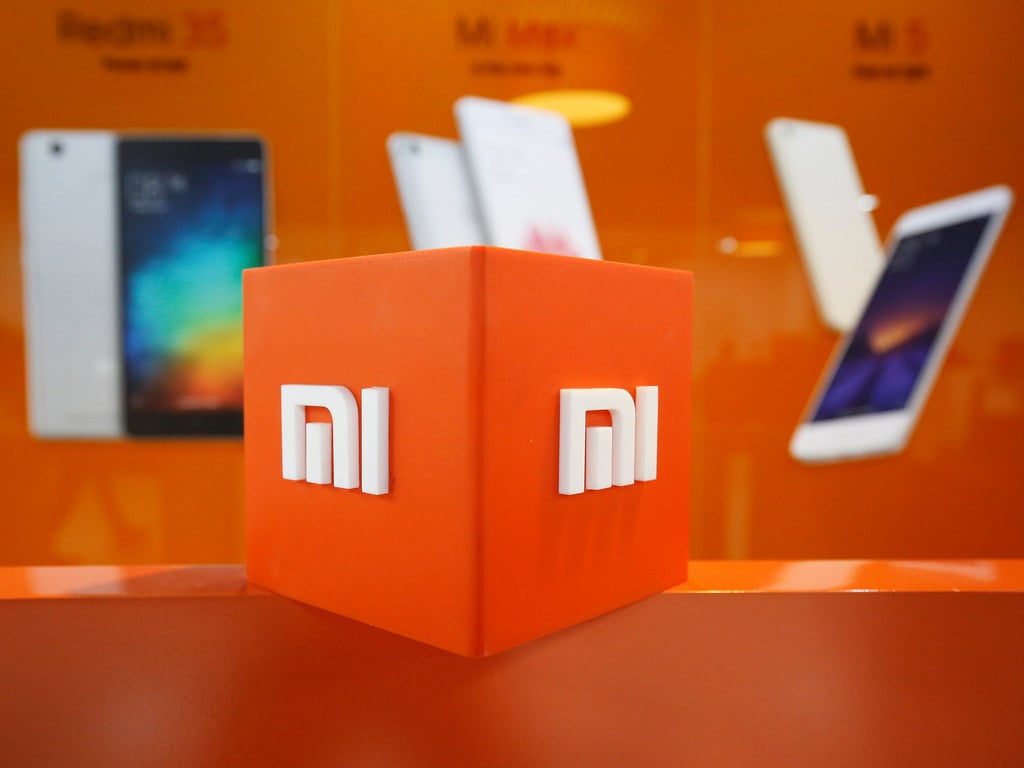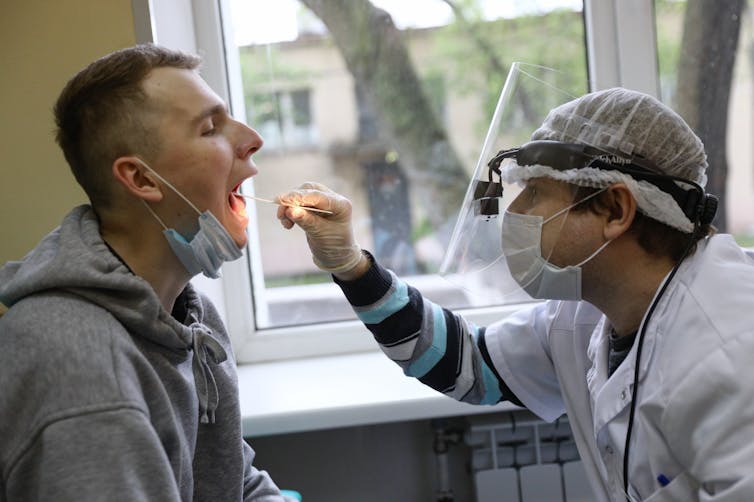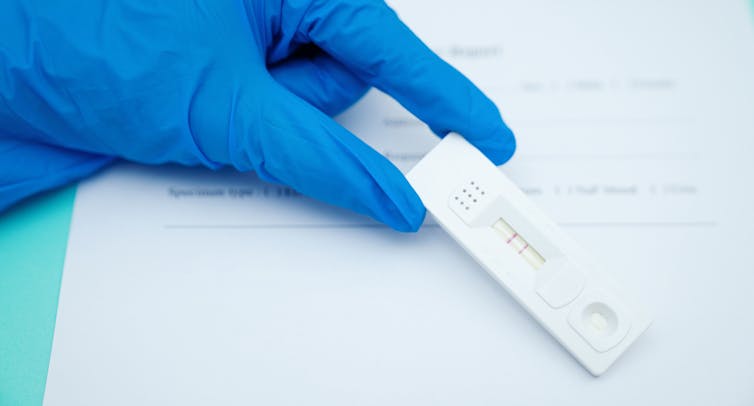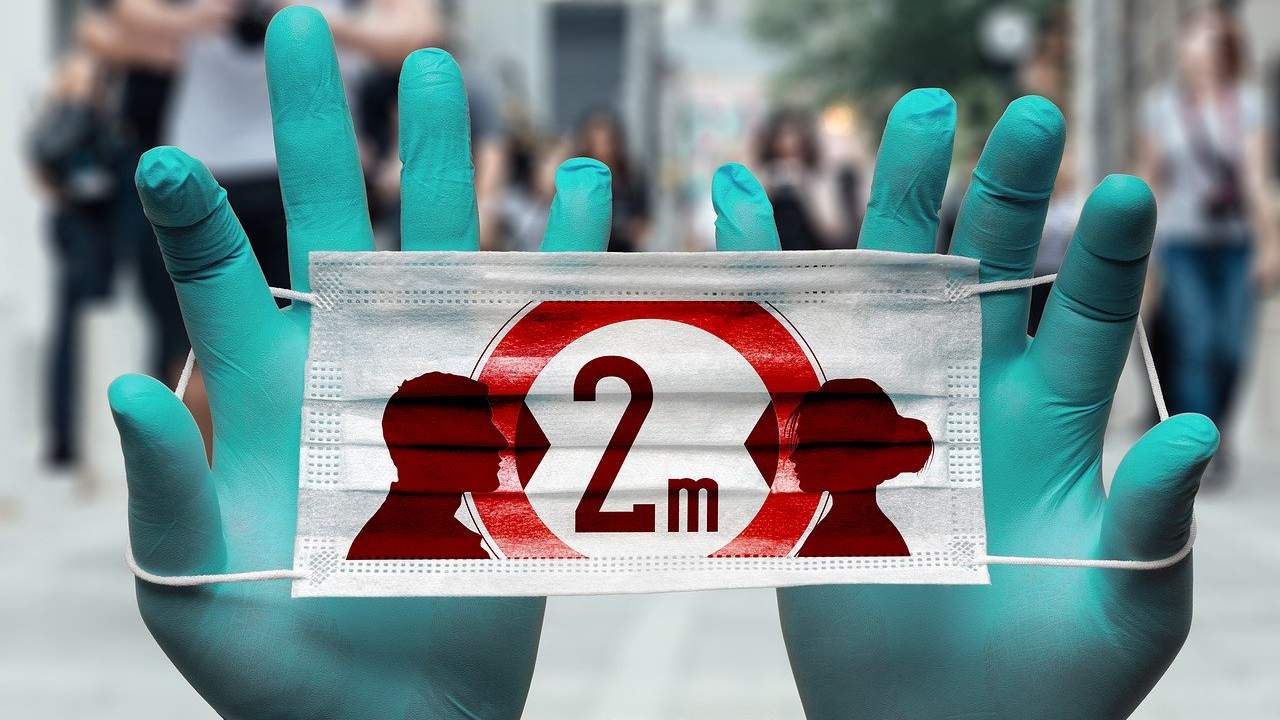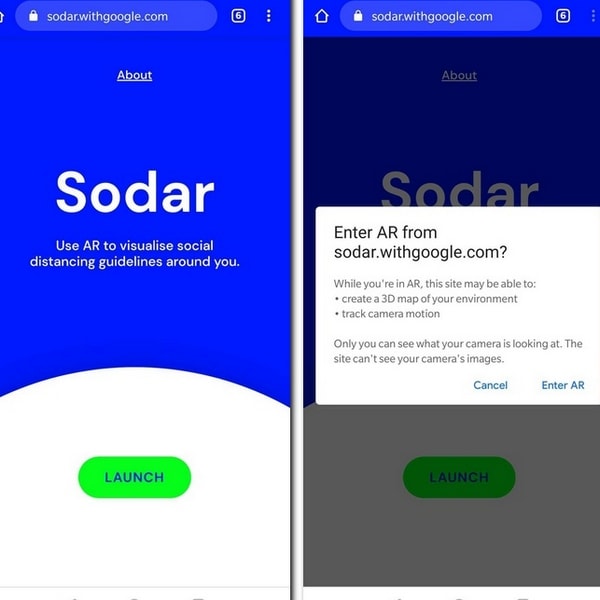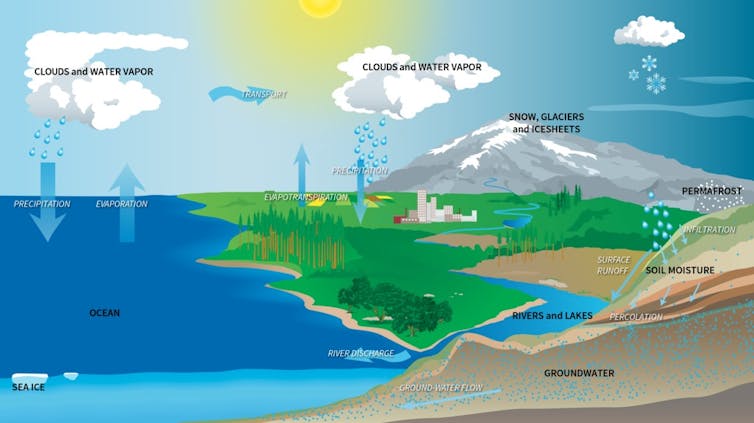Abigail BanerjiMay 30, 2020 21:04:39 IST
It was supposed to be a day of pride and joy for the Americans, who had not launched any of their astronauts into space for the last nine years. There were crowds gathered at what has been called the Florida space coast, and even the thought of potential infection by the novel coronavirus could not dampen their spirit. Even the pouring rain did not affect the faithful.
With under 17 minutes to go for liftoff, NASA and SpaceX announced that the first joint commercial human spaceflight mission would be ‘scrubbed’, or called off due to inclement weather. Both the space agency and the private aerospace company had mentioned that there was a possibility of the launch being postponed. An anti-climatic ending for what was going to be a momentous moment for America, since the Space Shuttle program was cancelled back in 2011.
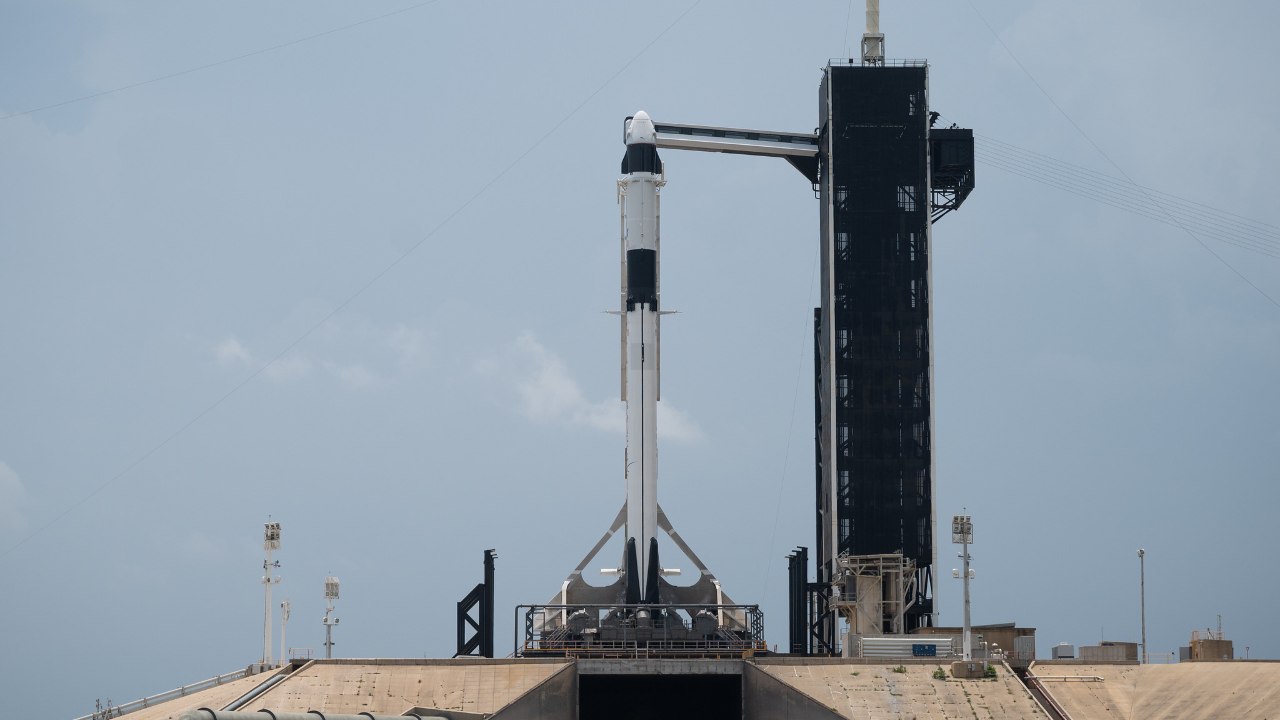
A SpaceX Falcon 9 rocket with the company’s Crew Dragon spacecraft onboard is seen on the launch pad at Launch Complex 39A during preparations for the Demo-2 mission. Image credit; NASA
Astronauts Doug Hurley and Bob Behnken will make the trip to the International Space Station on this milestone flight. NASA and SpaceX have rescheduled the launch to take place on Sunday, 31 May, 12.52 pm IST (May 30 at 3:22 p.m. EDT) from Launch Complex 39A at the Kennedy Space Centre, Florida. This was also the launch site for the previous Apollo and Space Shuttle missions and is being leased by SpaceX. It also has another back-up date on Monday, 1 June, 12.30 am IST (Sunday, May 31 at 3:00 p.m. EDT). Live coverage of the event will begin at 8.30 pm IST on 30 May, four hours before the launch is to take place.
The lift-off of the Falcon 9 has to be timed precisely to reach the space station, which is flying overhead 400 km above Earth at 17,500 mph. The spacecraft and crew have a launch window of one second (instantaneous launch window). If they miss it, the team will have to attempt it on another day.
However, even the second time around, the weather does not seem to be letting up. The Associated Press reported that “forecasters put the odds of acceptable weather conditions on Saturday (Sunday in India) at 50-50, with the outlook improving to 60 percent favourable on Sunday (Monday in India). Rain and clouds were the main concerns for both days.”
NASA chief Jim Bridenstine, during a press conference, expressed concern that the cancellations could be hard on the astronauts and the launch team. Hurley, however, tweeted on Friday that his first shuttle flight was scrubbed five times for weather and technical issues. Astronauts are no strangers to the possibility of cancelled flights. Safety first, always.
Here’s a look at the components that makes up the SpaceX/NASA launch:
Crew Dragon
The Crew Dragon is the modified version of the Cargo Dragon that SpaceX has been using during its re-supply missions to the ISS, since 2008. During the wet rehearsal on Thursday, one of the SpaceX experts said that to make the cargo dragon suitable for human beings, they only needed to add seats, displays and controls. The Cargo Dragon was already flying mice to the ISS for science experiments, so life support and environment control was already installed. They did have to bump it up a bit to ensure it could support humans. They also, for practical purposes, had to remove the ‘cargo cubies’ to make room for the astronauts.
Reusability is SpaceX’s MO, and the capsule follows in these footsteps. Partially. The capsule can last upto 10 flights before it needs a bit of elbow grease to be functional again. The spacecraft launches atop the Falcon 9 rocket and returns to Earth by splashing down in the ocean. Unlike its predecessor, the spacecraft can automatically dock itself to the ISS (Cargo Dragon needs to be manually berthed to the ISS) but the astronauts can take manual control if they want to enjoy the process of flying the capsule or in case of emergencies.

The Crew Dragon is the modified version of the Cargo Dragon that SpaceX has been using during its re-supply missions to the ISS.
The capsule carries its cargo in its trunk and one half of it is covered in solar panels, which will power the Dragon during its flight and when it is docked at the ISS. The trunk provides support to the capsule during ascent but will separate before it re-entry into Earth’s atmosphere.
In April 2019, a crew capsule was destroyed during a static fire testing. This caused some questions to be raised with regard to the safety of the capsule. However, the test was repeated in November 2019 without any incident.
The capsule also has an in-flight abort facility that will take its occupants to safety in case something goes wrong. During a test conducted in January 2020, an emergency like the situation was created and the Dragon successfully used its 8 SuperDracos abort engines to push itself and its trunk away from the Falcon 9, as intended.
There were several tests that needed to be done to ensure that NASA signed off on allowing its astronauts to travel by the Crew Dragon, however, we will be focusing on the two important ones.
Demo 1
On 2 March 2019, SpaceX’s Dragon capsule was launched, and on 8 March 2019, it completed its first unmanned flight test by docking to the ISS and returning to Earth after a five-day mission. This mission was called Demo 1. This was the first spacecraft that was built, operated and launched by SpaceX that was meant to charter human beings through space. It was also the first crew capsule that docked at the ISS on its own. The capsule can accommodate up to seven astronauts but will only carry 3-4 astronauts for NASA launches. For this test, it carried 200 kilograms of supplies and gear. During its stay, US astronaut Anne McClain and Canadian astronaut David Saint-Jacques ran tests and inspected the Crew Dragon’s cabin.
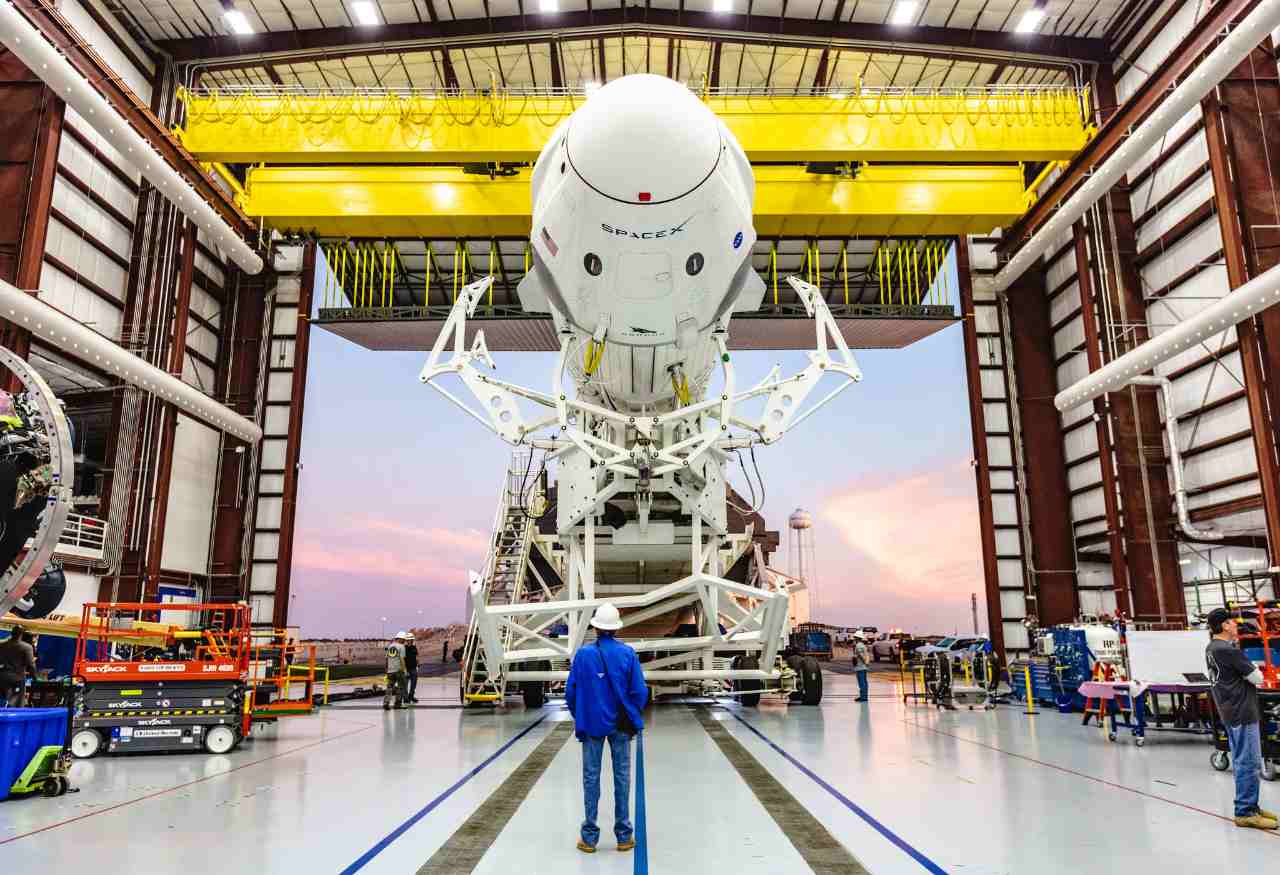
The Crew Demo-1 Mission. Image credit: SpaceX/Flickr
Since this mission was supposed to test the safety of the capsule, SpaceX couldn’t possibly have an actual human sitting inside. So the team did the next best thing: they put in a test dummy that’s named after and looks identical to Eileen Ripley from the Alien films. Dummy Ripley also wore the same white SpaceX spacesuit that astronauts are supposed to wear during their missions. Ripley is similar to Starman, the dummy that sat in the front seat of a red Tesla convertible, which blasted off last year during a test launch of the company’s bigger Falcon Heavy rocket.
Demo 2
After a successful first trial mission, the upcoming mission to the ISS has been termed ‘Demo 2’ and will carry the two astronauts — Hurley and Behnken.
After a not-so breezy start on Thursday, this mission has been rescheduled for Sunday, 12.52 pm IST. Fans and the team really want this launch to happen. A lot is riding on Demo 2 making a good first impression with living astronauts onboard. If all goes well, NASA will approve SpaceX to carry other astronauts to the ISS, along with the commercial re-supply runs it has been making since 2008. This will halt NASA’s dependence on the expensive Russian Soyuz program, and will be more cost-effective in the long run as well. One seat on SpaceX’s Falcon 9 costs around $ 55 million, as compared to the $86 million per seat that NASA pays Russia to ferry its astronauts. It will also mean that SpaceX is one step closer to going to Mars, and beyond.
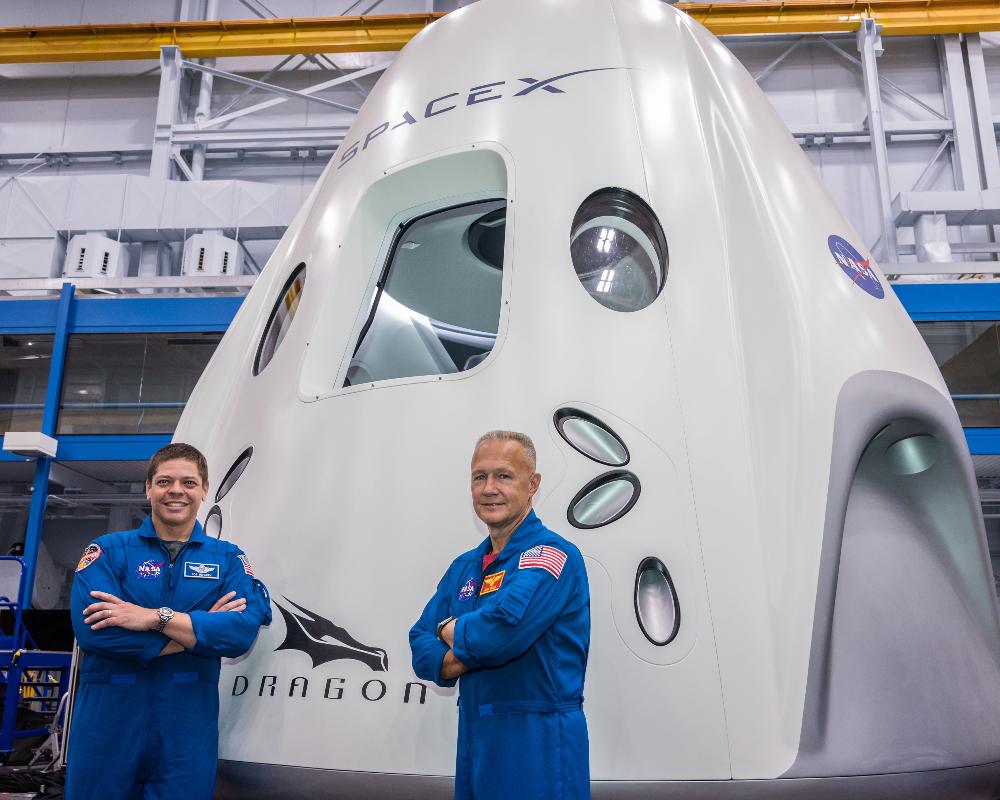
NASA astronauts Bob Behnken and Doug Hurley stand near the cargo dragon. Image credit: NASA
The actual duration of this trip has not yet been decided, and a call will be made once the capsule reaches the space station. Initially, NASA had said that the astronauts will stay at the ISS for a week. A few days before the launch, NASA made the decision to extend their stay to for anywhere between one to four months. Currently, the ISS is understaffed, and their longer stay will mean that the two American astronauts can help man the station. It will also give them a chance to help swap out the station’s batteries, a task that requires a spacewalk that Chris Cassidy cannot do alone.
According to a NASA blog, the Crew Dragon can stay in orbit for 110 days but NASA requirements state that it needs to be able to stay at the ISS for 210 days. NASA has also bought one seat on the Soyuz rocket for $90 million to ensure that the station will have enough US presence.
Falcon 9 rocket
The name Falcon 9 is derived from the Millennium Falcon, a spaceship from the movie Star Wars. It is a partially-reusable two-stage-to-orbit launch vehicle. The first stage is capable of re-entering the atmosphere and landing vertically after separating from the second stage, which has a single Merlin Vacuum Engine to deliver its payloads to whichever orbit is required. The second stage engine can be restarted multiple times to deliver multiple payloads into different orbits. The first stage is powered by nine Merlin engines that use liquid oxygen and rocket-grade kerosene as propellants.
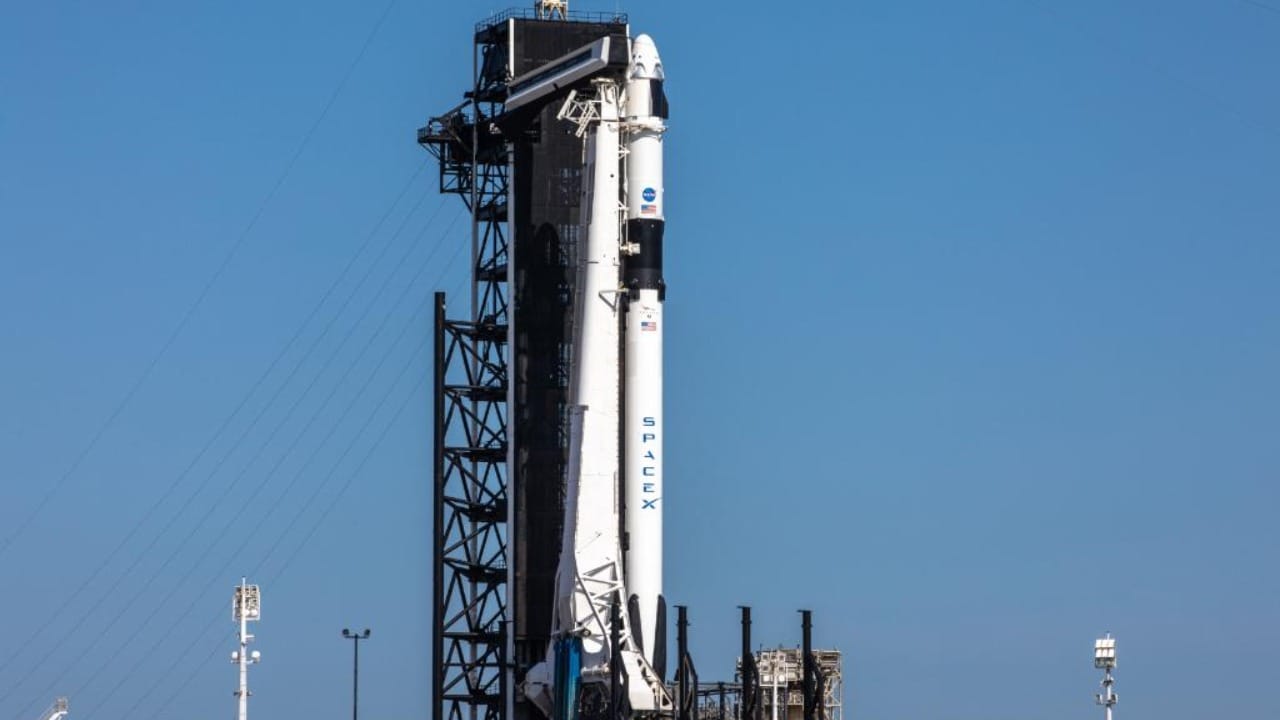
The Spacex Falcon 9 stands upright before its launch. Image credit: Twitter/NASA
A two-stage-to-orbit or two-stage rocket launch vehicle is a spacecraft in which two distinct stages provide propulsion consecutively in order to achieve orbital velocity.
SpaceX successfully landed its first stage during its 20th flight in December 2015. They have also been recovering its payload fairing — that houses satellites — to re-use on future missions
In 2018, SpaceX introduced the Falcon Heavy version that could carry heavier payloads and used two normal Falcon 9 first stages as side boosters to propel it ahead.
About the astronauts
Hurley and Behnken have extensive experience in space and have been involved in NASA’s Space Shuttle flights.
Behnken will be the joint operations commander in this mission and was selected as a NASA astronaut in 2000. He has completed two space shuttle flights — STS-123 in March 2008 and STS-130 in February 2010 — and performed three spacewalks during each mission.
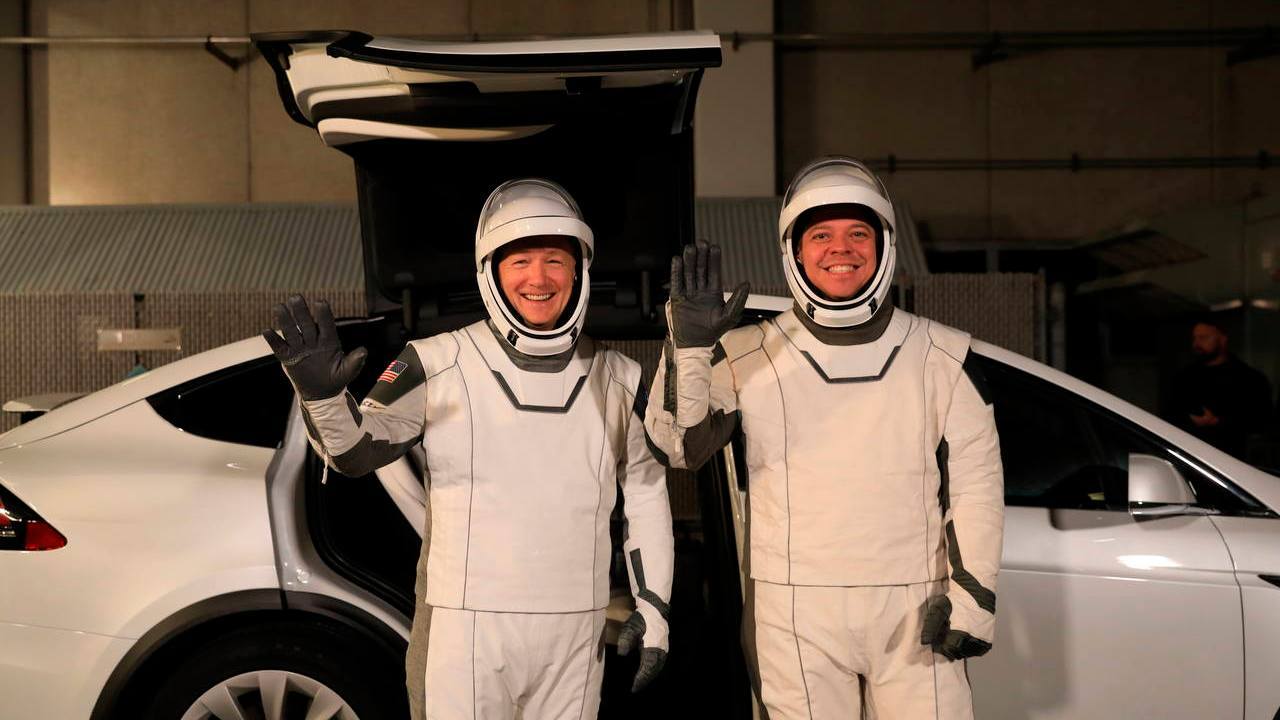
Astronauts Bok and Dough during the SpaceX InFlight Abort Dry Dress Rehearsal.
Hurley was selected as a NASA astronaut in 2000 and will be the spacecraft commander for Demo 2. He has completed two spaceflights – STS‐127 in July 2009 and STS‐135 — the final space shuttle mission — in July 2011. He was the pilot and lead robotics operator for both missions.
What can we expect to see during the LIVE broadcast
Pre-launch
During the Space Shuttle era, astronauts would travel in an Astro-van which both Hurley and Behnken would’ve travelled in since they were both part of this program. But this time around they will arrive in style with their cool, matchy-matchy, custom-made, astronaut suits and travel in a Tesla Model X sports cars to the Launch Complex 39A at the Kennedy Space Centre after waving goodbye to their families from a distance. The number plates, during the wet rehearsal, read ‘ISS BND’.
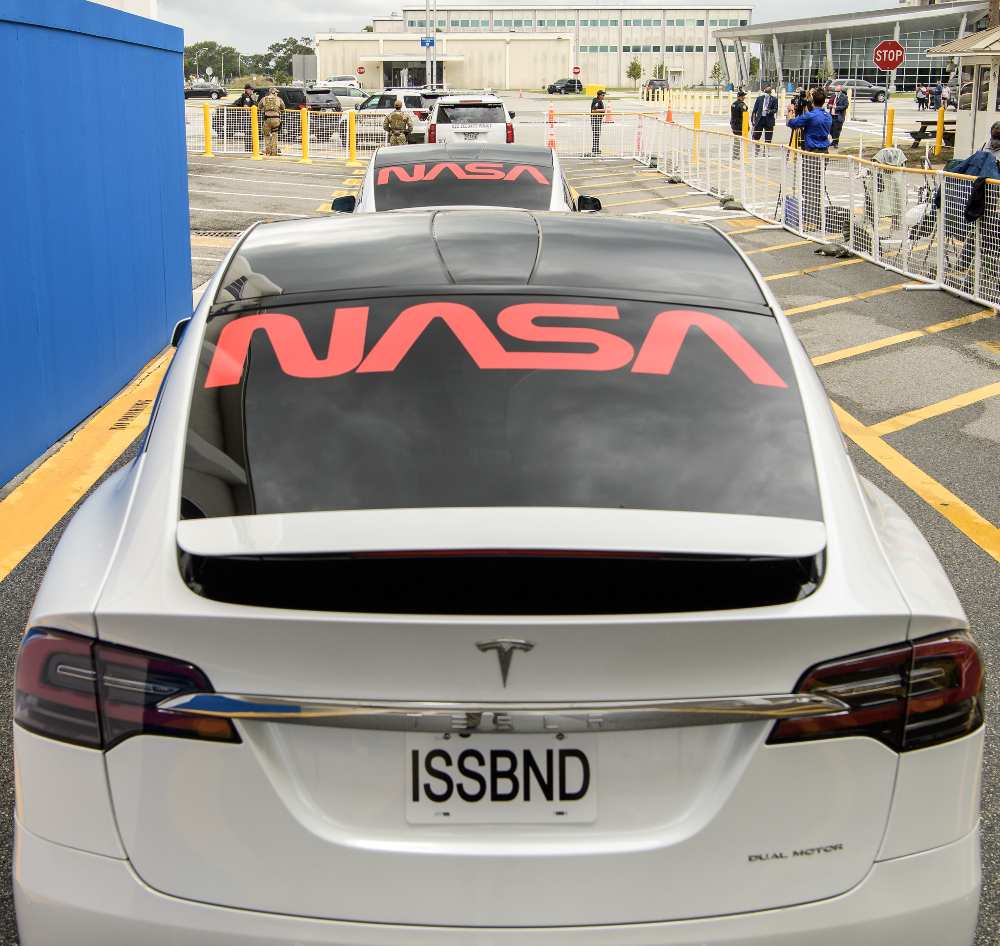
The Tesla Model X sports cars that was used to transport the astronauts to the Launchpad 39A. Image credit: NASA/Flickr
They will walk down the Astro arm that connects to the capsule and the launch team that will help them get strapped in. Soon the communication checks then begin with the ground team to ensure that the astronauts are in constant touch in the event of an emergency.
After the hatch is closed, fueling begins. Unlike other rockets, SpaceX’s rockets are fueled only after the astronauts are inside the capsule. SpaceX makes their own rules, but they have some logic behind this dicey method. The Verge reports that SpaceX uses extremely cold propellants, which gives the vehicle a performance boost. By loading the fuel just half an hour before launch, the fuel has less time to heat up and boil away.
Launch
If the weather is on their side, they will get the all-clear from the mission director and the countdown to launch will begin. SpaceX will become the first private company to send astronauts to space this Sunday. However, the mission can be cancelled at the last moment as it happened on Thursday.
About 2.5 minutes after liftoff, the first stage booster will detach from the rocket and return to Earth. It will land on SpaceX’s drone ship called “Of Course I Still Love You” that is stationed in the Atlantic Ocean, off the coast of Florida.
Following the first stage, the second stage will also detach from the Crew Dragon capsule. Unlike the first stage, this will not directly return to Earth and SpaceX will not be spending any of its resources to make it reusable.
Post-launch
The Dragon will then orbit the Earth and undertake a series of what are known as ‘phasing burns’ i.e. re-ignite its engines to propel it to the next level in order to play catch-up with the ISS, that is travelling at a speed of 7.66 km/s.
Dragon is supposed to automatically dock with the ISS after 19 hours of raising its altitude to match that of the ISS. The astronauts will have a sort of a welcoming ceremony waiting for them.
Hurley and Behnken will stay on the ISS for anywhere between one to four months doing science experiments and helping in the upkeep of the station.
Once NASA deems it is a good time to return, the astronauts will then begin their journey back home. They will strap in and undock from the ISS.
Before it re-enters the Earth’s atmosphere, the Crew Dragon will lose its trunk. This, like the second stage, will not be returning to Earth.
The re-entry of the dragon will look somewhat scary, like a ball of fire but the heat-shields will ensure no harm comes to the astronauts.
Four Mark 3 Parachutes will be deployed that will slow down the entry of the vehicle, and Dragon will splashdown in the Atlantic Ocean. The astronauts will be fished out of the water along with the Dragon capsule, which will be inspected at the Cape Canaveral facility in Florida.
